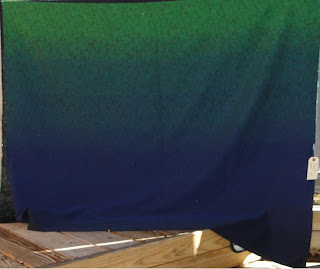
You certainly can’t see the seams in the jacket on the pattern envelope. But the line drawings show them well.

I felt that if I was going to spend the time and effort to sew those curved seams, I wanted them to be visible is some way. I enlarged the line drawing and played around with my crayons. Besides the obvious color blocking options, another one I came up with was ombre coloration.

I pictured the fabric as wool where the color change was woven, not printed and there was texture or other interest in the fabric. I had no luck finding this fantasy fabric anywhere. I ordered some silk suiting and wool fabrics thinking I might ombre dye them myself, but I never got around to it. This fall I was browsing the Elliott Berman Textiles website and there was some fabric that had the ombre coloration I was looking for.

It was described as 2 Matelesse panels – made in Italy, with no info on fabric content.

It changed from a dark navy color at one end of the fabric to a bright green at the other end. I was hoping it was silk based on the price. It was on sale, but still above my $/yard comfort level. When it arrived the fabric proved to be quite interesting and unique. It was polyester, with a texture that resembled rough tree bark. The texture started out as ridges in the dark blue area and turned into cracks as they moved into the lighter bands of color. In the top green band the cracks were plentiful. The interiors of the cracks had shiny black fibers woven into them. The black fibers are actually thin flat polyester strips, very similar to the Sulky Sliver metallic thread you can buy for embroidery and embellishment. These strips float on the back of the fabric, except where they were woven into the cracks. The fabric was easy to cut and press, but no matter how thin and sharp the needles and pins I used, they often pushed the black strips through the layers to the outside of the fabric. Fortunately this did not cause a snag or pucker in the outer layer of the fabric so I finally just ignored it.

This jacket is a fair amount of work. The pattern includes the pieces for the interfacing at the sleeve hems, jacket hem, armhole and upper back, which was nice. Sewn in interfacing is recommended and that is what I used because I was unsure how well fusible interfacing would adhere to the polyester fibers. I laid out the pattern pieces so that color changed from mid tone to light on the sides of the jacket and dark to mid tone in the center of the jacket. I made the welt pockets out of a darker color than the surrounding fabric so they sort of resemble a belt as they go under the curved section. The pattern instructions are very good, describing the steps needed to complete the unique features and assembly order of this jacket. I had no trouble matching and sewing the curved seams. The only things I did not like about the instructions/pattern was the non functional sleeve vents. They were bulky when constructed as per the instructions. And instead of a button hole on the sleeve vent, the instruction have you make a line of chain stitching to look like a button hole.



I am really pleased with the finished jacket, and though the fabric is totally different than what I pictured, it did fulfill my vision. I am in the process of making a scoop neck top and wide leg pants (not from this pattern) of navy georgette to wear with the jacket. I plan to wear this outfit to a company sponsored reception and special viewing of the Pablo Picasso: Masterpieces from the Musée National Picasso, Paris exhibit at the VA Museum of Fine Arts.
Here is some picture of the jacket on me because I think it is important to show garments on real people, not just dress forms.



